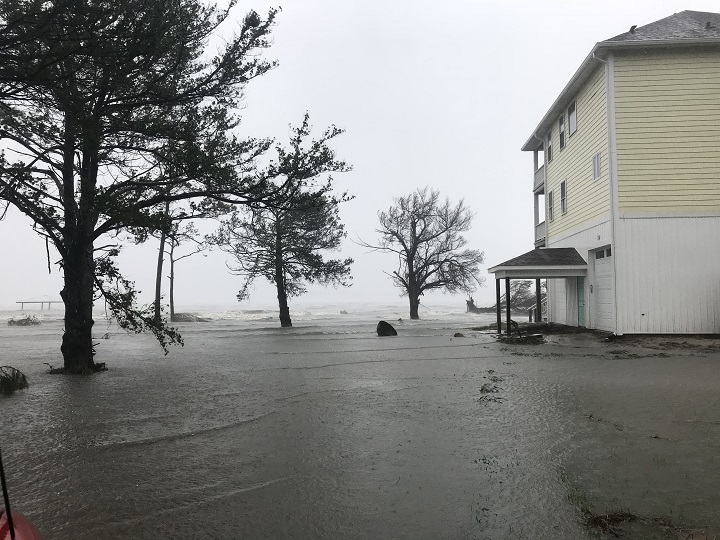
DOWN EAST CARTERET COUNTY – Hurricane Florence ravaged in mid-September most of the coast of North Carolina, leaving a trail of billions in damage and untold destruction.
Down East Carteret County, more than a dozen unincorporated but close-knit communities situated between Beaufort and Cedar Island, is in the beginning stages of recovery from the disaster that caused many to lose their homes, their businesses and their life’s work.
Supporter Spotlight
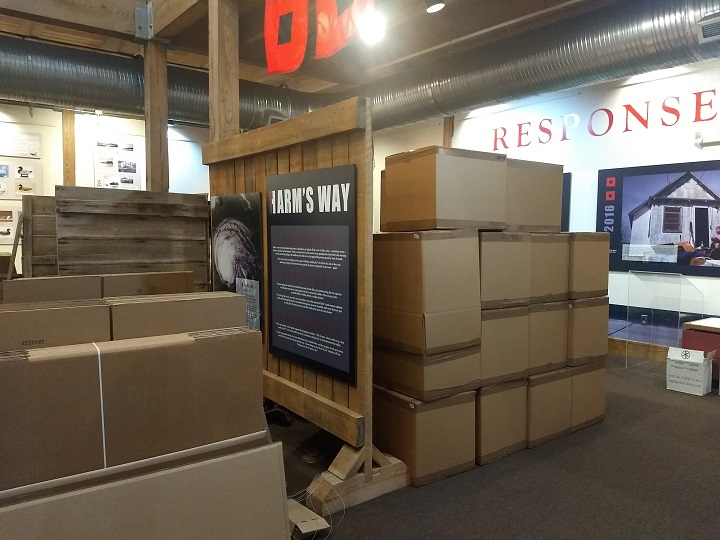
The Core Sound Waterfowl Museum and Heritage Center on Harkers Island was hit especially hard. Once filled with artifacts that illustrated life Down East, the museum was nearly empty Friday afternoon, save for boxes of various sizes waiting to be moved and equipment brought in to help manage moisture.
Pam Morris, exhibition curator, weaved through movers working on the second floor. She said that there was no damage to the artifacts because the items were either covered in plastic or in a case, and nothing was wet in the office, which they were in process of packing up.
Morris explained, “We basically have to vacate the building for demolition, and they’re going to redo the floors, sheetrock and roof.”
She added that they have fine arts insurance as well as facility insurance. Fine arts handlers packed up the collection for further documentation and light conservation work to be done while the building is being repaired and the museum gift shop has been relocated to a storefront at 806 Arendell St. in Morehead City for the time being.
We’re going to have to figure out what we can do to be in better shape for the next storm, roof wise, which is probably the case for a lot of people,” she said.
Supporter Spotlight
Worst-case scenario is that it will take six months to have the building operational, she said, and there are no preliminary numbers on funding they’ll need to get back open.
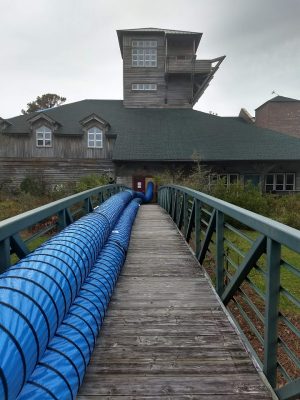
Morris said if folks wanted to help but couldn’t make it to Harkers Island, the museum website has a page marked to donate for the recovery effort.
“That’s how people can help, we’ve had tons of help from the community, thank God for them, but we also need other help as well. We would be so appreciative if they logged onto our website and made a contribution earmarked for the relief effort,” she said.
“We’re going to recover, be better than ever, and I think we’re going to come out in on the other side in probably better shape than we were going in,” Morris added.
Terry Krauss of Carrboro was volunteering Friday afternoon at the museum. He said that he and his wife are big fans of Harkers Island and Cape Lookout. “We visit regularly, so when they had this disaster, I decided to spend some time down here helping people I know, doing everything from putting tarps up, hauling trash to the drop off center, chain sawing trees.”
Near where Krauss was helping upstairs, Lynn Hess, who works at the museum, was in an office sorting through documents. Hess said that she and her husband are in the process of revamping their 108-year-old home in Atlantic and while they had some water damage from broken windows, “Compared to what other folks are dealing with, we’re very fortunate.”
She added, “The community came together beautifully, which is one of the things we dearly love about Down East.”
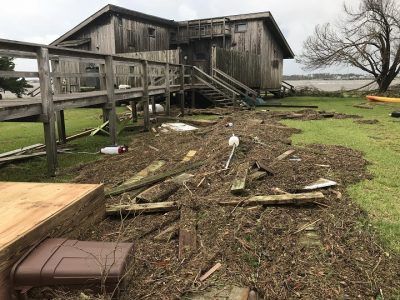
Gloucester resident Barbara Garrity-Blake was also taken by the outpouring of kindness showed during and after the storm.
“The damage Down East, like in so many areas, is devastating, but response to the storm’s aftermath has been overwhelming,” she said. Fire departments Down East were the points of emergency supply drop off and distribution and firefighters and other first responders worked around the clock clearing roads, checking districts and fielding calls.
“I helped give out cleaning kits, MREs (meals ready to eat), water, canned goods, clothes and so on at the Marshallberg Volunteer Fire Department. We had crews of U.S. Forestry workers who helped unload tractor trailers — they were awesome,” Garrity-Blake said. “Churches stepped up and helped feed people. The Salvation Army folks were lifesavers with meals and supplies. Red Cross and Lion’s Club are examples of so many organizations that helped. Chowan County sent a 4-H team with livestock feed and hay.”
Garrity-Blake said that many took it upon themselves to drive in from Asheville, Raleigh, Charlotte, you name it, to help.
“I was especially moved by a Hispanic family – mother, teenage daughter and little boy – who drove two hours from flood-ravaged Kinston. When I asked them what they needed, they told me they didn’t need a thing – they had come to help Down East,” she said. They came with a van full of bleach to donate and helped at the Marshallberg Baptist Church serve meals that evening.
“Now we are in the muddy, mosquito-infested grind of long-term recovery. My heart goes out to those who were displaced, and whose possessions are on the side of the road.”
Barbara Garrity-Blake
“Now we are in the muddy, mosquito-infested grind of long-term recovery. My heart goes out to those who were displaced, and whose possessions are on the side of the road. Thank goodness for the Baptist Men, the Latter-day Saints and others who continue to do the dirty work of helping clear trees and deal with flooded homes,” she said, adding that some have no place to go and the Federal Emergency Management Agency cannot help. “People need temporary housing and FEMA no longer provides trailers.”
The Down East Council, which serves as a voice for the communities, is meeting 7 p.m. Tuesday at the Davis Volunteer Fire Department, she said, “to talk about how we can improve storm preparation and response for the next time, and we know there will be a next time. It’s appropriate that we are meeting in Davis, the epicenter of damage Down East.”The discussion will also focus on addressing concerns at the county level.
Lillie Chadwick Miller with the Down East Council reiterated the level of damage Florence produced throughout the county and especially the communities Down East.
“Many agree it produced more damage than ever before; and another comment reflected the fact that water came higher onto their property than they have ever seen,” she said.
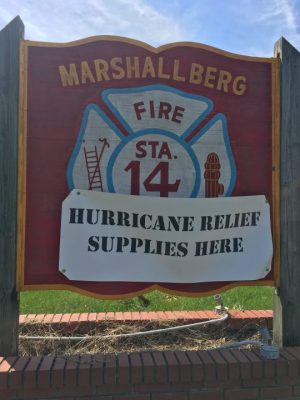
“However, with the destruction that took place, many good things resulted. Friends were helping friends. Neighbors helping neighbors. Members of the fire and rescue departments worked above and beyond to accept the thousands of donations and disperse them to community folks,” MIller added. “Many members of the community stepped up and began organizing with friends outside of our county to get donations into our communities.”
What was the most humbling, she continued was to see the quantity of supplies that poured into the Down East communities, “And they’re still coming in. It’s amazing how the human spirit always steps up in times of need.”
In terms of recovery, Miller said it will be slow for many.
“Many homes are totally destroyed and the families are displaced. The lack of housing is a huge problem and those that are unable to stay in their homes because of the damage are finding it extremely difficult to find a place to house their families,” she said. “This is causing more stress on so many people with very few options open to them.”
Miller continued that with more and more homes deemed uninhabitable, the residents are finding themselves in dire situations.
“Families are struggling and finding it impossible to get help from FEMA and in some cases their own insurance. Families are told their homes are uninhabitable; but with no places to even rent, they are literally left with no viable choices. And then many cannot afford home insurance, much less flood insurance. It is definitely an extremely difficult situation for many Down East.”
Miller mentioned how heartbreaking it is to see how the Core Sound Waterfowl Museum has been damaged. “For so many, the museum is an icon of our communities. Like always, folks will work together to help restore the museum to what it was before.”
Among those pitching in at the museum was Liz DeMattia, lead scientist for the Community Science Initiative at Duke University Marine Lab, along with faculty, students, staff and their family members.
“Families are told their homes are uninhabitable; but with no places to even rent, they are literally left with no viable choices. And then many cannot afford home insurance, much less flood insurance. It is definitely an extremely difficult situation for many Down East.”
Lillie Chadwick Miller, Down East Council
“The Core Sound Museum and Heritage Center is such an important space for the community and has been a wonderful community partner for faculty, staff and students at the Duke Marine Lab,” DeMattia said. “When we heard what Florence did to the museum, we wanted to give back to an organization that gives so much to everyone else. We have such respect for the museum, that we contacted (museum director) Karen Amspacher and said ‘how can we help’?”
Many different groups have helped out from Duke Marine Lab in whatever capacity the museum staff needed, DeMattia explained. She said that groups shoveled mud and ripped carpets at one of the Down East churches, cleaned storage spaces to make space for museum furniture and packed up the gift store and some contents from the museum’s community exhibits.
“Anyone who has worked with the (museum) staff knows how community oriented and hardworking they are, and how much they give to the museum and the community — as friends and partners of Core Sound, our goal was just to lighten their workload and help them on the road to restoring such a wonderful community space.”
In a note to museum supporters, Amspacher wrote “Eastern North Carolina has suffered a disaster for sure, and Core Sound and Down East are just part of a much larger tragic situation, but we – like generations before us – will adapt, work and persevere.”







